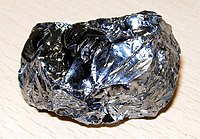
Photo from wikipedia
Abstract Spent cathode carbon (SCC) is the largest and most inevitable hazardous solid waste continuously discharged from the aluminum electrolysis industry. In this study, mechanical activation was used to assist… Click to show full abstract
Abstract Spent cathode carbon (SCC) is the largest and most inevitable hazardous solid waste continuously discharged from the aluminum electrolysis industry. In this study, mechanical activation was used to assist alkali fusion treatment in dissociating toxic substances and recovering graphite carbon from SCC. The effect of mechanical activation (i.e., milling speed, ball-to-material mass ratio, and milling time) on the alkali fusion treatment was investigated. Its effect on the physicochemical properties of SCC–Na2CO3 mixtures was also analyzed through particle size distribution, Brunauer-Emmett-Teller surface area analysis, scanning electron microscopy, X–ray diffraction and thermogravimetric analysis–differential scanning calorimetry. Results showed that mechanical activation enhanced the alkali fusion treatment by improving the physical separation of fluoride, the mixing uniformity and reaction contact area of SCC and Na2CO3, and promoting the conversion of Na2CO3 to Na2O. The formation of agglomerates was the main reason that the carbon content of recovered graphite carbon and the fluoride ion leaching rate increased initially then decreased with the increment in mechanical activation conditions. Under optimal mechanical activation conditions, the carbon content of recovered graphite carbon and the fluoride ion leaching rate increased from 89.35% and 76.50% (non-activated sample) to 93.93% and 95.02%, respectively, indicating that mechanical activation assisted alkali fusion treatment effectively enhanced the separation efficiency of fluoride and graphite carbon. In addition, thermodynamic analysis of the alkali fusion treatment and characterization of recovered graphite carbon (under the optimal mechanical activation conditions) were performed. Results demonstrated that the simultaneous conversion of multiple fluorides (i.e., Na3AlF6 and CaF2) and oxidative decomposition of cyanide in SCC can be achieved via mechanical activation assisted alkali fusion treatment. These findings indicate that mechanical activation–assisted alkali fusion treatment is a promising method for the detoxification and utilization of SCC.
Journal Title: Minerals Engineering
Year Published: 2020
Link to full text (if available)
Share on Social Media: Sign Up to like & get
recommendations!